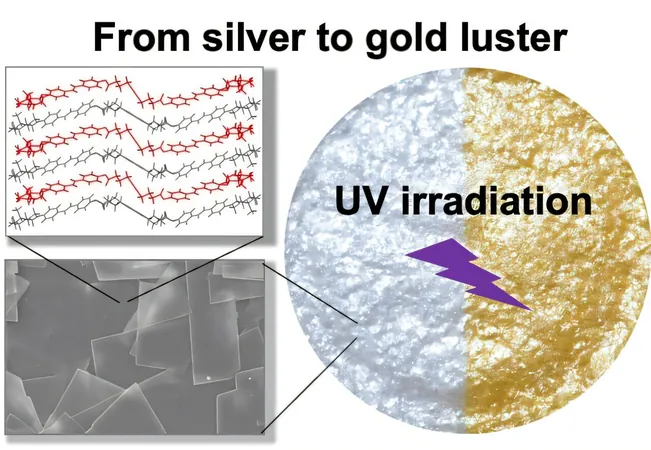
Breakthrough Material Changes from Silver to Gold Under UV Light – A Game Changer in Sustainability!
2024-10-30
Author: Li
Introduction
In a remarkable advancement, researchers at Chiba University have developed an innovative metallic luster material that transitions from silver to a striking gold when exposed to ultraviolet (UV) light. This breakthrough, led by Professor Michinari Kohri and his team, marks a significant step forward in the quest for sustainable and versatile materials that challenge traditional metal use.
The Allure and Limitations of Precious Metals
While the allure of precious metals like gold and silver appeals to humanity's sense of luxury and nobility, their high costs often limit their accessibility and application. The rise of artificial gold- and silver-like materials has filled this gap, commonly employed in jewelry, reflective surfaces, inks, and cosmetics. However, the environmental toll of conventional metallic materials has prompted a pivotal shift toward more sustainable alternatives.
Challenges in Finding Eco-Friendly Alternatives
Many researchers are exploring metal-free options, trialing organic compounds like thiophene and porphyrin derivatives that exhibit metallic luster similar to traditional metals. This quest has proven challenging, as maintaining a luxurious metallic shine while being eco-friendly isn’t easily accomplished.
The Breakthrough at Chiba University
The breakthrough from Chiba University involves diacetylene derivative-based luster materials that incorporate specially designed molecules known as stilbenes. These materials, denoted as DS-DAn, were created by manipulating the linker carbon numbers, showcasing different luster properties. Notably, the derivative with the shortest linker, DS-DA1, stands out with its unique crystal structure that exhibits a dazzling silver luster which transforms into gold under UV irradiation—a stunning feat of material science!
Mechanism of Color Transformation
The researchers found that this color transformation stems from a specific arrangement of molecules within the crystal, leading to a partial topochemical polymerization. This process permitted the DS-DA1 to momentarily alter its structural appearance, effectively changing its color.
Potential Applications
The potential applications for this groundbreaking material are vast. With capabilities to produce selective golden luster in designated areas via light stimulation, it opens up new avenues in decorative arts, printing technologies, and even cosmetics. Moreover, the ability to create gradient effects between gold and silver enhances its aesthetic versatility.
Environmental Benefits and Future Prospects
Professor Kohri emphasizes the environmental benefits of this development, stating, "By eliminating metal components, our material significantly reduces its ecological footprint and weight. This opens up exciting possibilities for advanced decorative printing techniques utilizing UV lasers." He also hints at future innovations, suggesting that continued exploration of molecular designs could lead to a broader spectrum of glossy colors.
Conclusion
Published in ACS Applied Materials & Interfaces on September 14, 2024, this study not only contributes to the growing field of sustainable materials but also pushes the boundaries of what we can achieve through advanced material science, with promising implications for photomask patterning and UV laser lithography. This revolutionary material could redefine how we view and utilize metallic finishes, providing an eco-friendly alternative that harmonizes luxury with sustainability. Keep an eye out for developments in this thrilling area of research—it could change the landscape of materials forever!


 Brasil (PT)
Brasil (PT)
 Canada (EN)
Canada (EN)
 Chile (ES)
Chile (ES)
 España (ES)
España (ES)
 France (FR)
France (FR)
 Hong Kong (EN)
Hong Kong (EN)
 Italia (IT)
Italia (IT)
 日本 (JA)
日本 (JA)
 Magyarország (HU)
Magyarország (HU)
 Norge (NO)
Norge (NO)
 Polska (PL)
Polska (PL)
 Schweiz (DE)
Schweiz (DE)
 Singapore (EN)
Singapore (EN)
 Sverige (SV)
Sverige (SV)
 Suomi (FI)
Suomi (FI)
 Türkiye (TR)
Türkiye (TR)